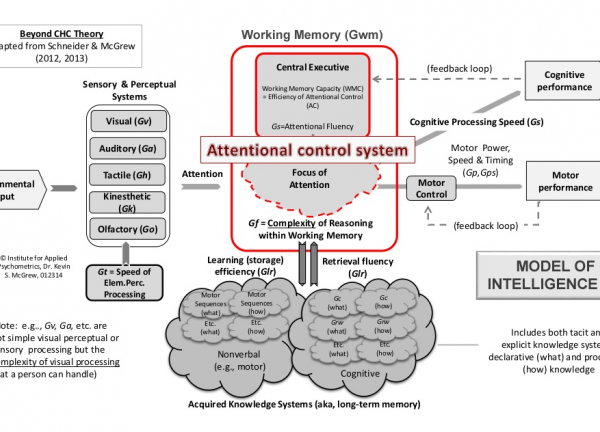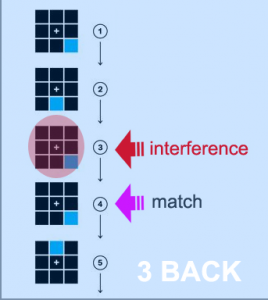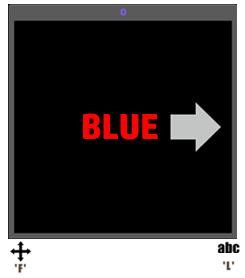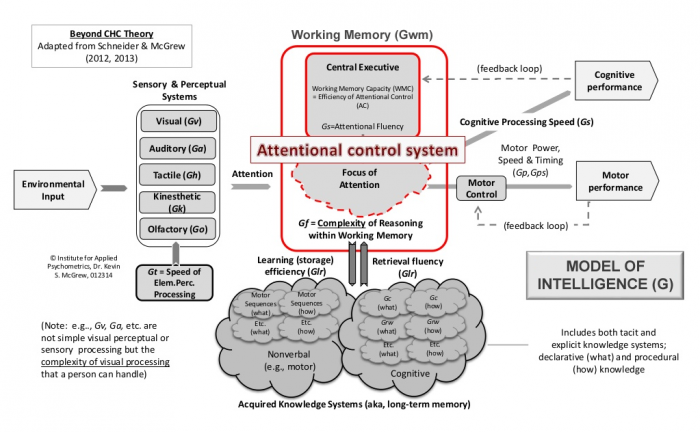HighIQPro is designed to improve cognitive performance & cognitive capital by increasing IQ, strategic insight, attention control and mental resilience. These all benefit mental performance. They are also scarce resources that can be traded with career success, money, social impact and political power.
Scientific Basis of the 2nd Generation DNB Formula
![]() We know from a largely skeptical scientific press that many brain training apps do not work beyond practice effects specific to the games themselves (ref). But it has become clear from the ever-growing weight of peer-reviewed research that some types of brain training are effective for increasing IQ and cognitive control (1).
We know from a largely skeptical scientific press that many brain training apps do not work beyond practice effects specific to the games themselves (ref). But it has become clear from the ever-growing weight of peer-reviewed research that some types of brain training are effective for increasing IQ and cognitive control (1).
This post has been written to help explain the science underlying HighIQPro’s 2G+ DNB formula for increasing IQ, and how the app works in terms of the underlying brain processes. We’ll find that 2G+ DNB brain training combines into one powerful intervention package 4 major branches of cognitive neuroscience research – an intervention that is dedicated to increasing IQ – a measure of general intelligence (G).
Working Memory & Attention Control Training
One of the main principles of HighIQPro’s 2G+ DNB brain training is that it targets the brain’s working memory (WM) and attention systems as a way of increasing IQ.
Working memory is your ‘mental workspace’ – the amount of information you can focus on and process ‘online’ for problem solving, reasoning, planning, comprehending & decision-making. Our WM capacity can also be thought of as our ability to control attention to manage the information our brain processes, and WM capacity is key factor of IQ measured in the most widely used professional IQ tests (e.g. WAIS-IV). Along with other researchers (see figure), we understand WM and attention control to lie at the heart of general intelligence (G).
 The 2nd generation DNB formula combines working memory and attention control (sometimes called executive control) training – and is based on 5 branches of cognitive neuroscience research:
The 2nd generation DNB formula combines working memory and attention control (sometimes called executive control) training – and is based on 5 branches of cognitive neuroscience research:
1. Dual N-Back: Evidence Based Increase IQ Training

The dual n-back (DNB) is the most widely studied brain training game with scientific credibility. It targets working memory capacity. There are many versions of the dual n-back game available online and in app stores, and Some implement the lab versions more accurately than others. Many thousands of us have trained with the DNB and felt its brain benefits.
DNB brain training increases IQ in both working memory (Gwm) and fluid reasoning (Gf) – as well as improving attention control. The very latest 2017 ‘meta-analysis’ of all 33 published, randomized, controlled DNB trials from independent labs all around the world (ref) finds there are real training effects of DNB brain training on IQ, beyond placebo effects and just getting good at the n-back game itself through practice.
Dr Au and colleagues’ earlier 2015 meta-analysis also found the same effect size of DNB brain training on fluid intelligence (ref). So we have two independent groups, reviewing all the available evidence on DNB training, coming to the same conclusion. Evidence doesn’t get better than this.
How can we interpret these effect sizes? The effect size for working memory capacity (Gwm) is 0.24. This is the same effect size of antidepressants such as Fluoxetine (Prozac) in treating depression (ref). Certainly a lot has been invested in anti-depressants for their effectiveness! So we should take notice of this kind of effect size when it comes to improving IQ.

DNB brain training is known from multiple studies (Ref 1, Ref 2, Ref 3) to result in neuroplasticity change in the the fronto-parietal network (FPN). This is the brain’s ‘control hub’ and is also called the ‘executive control network’. It sends out top down signals for current task goals and exerts control by flexibly biasing information flow across multiple large-scale functional networks. The FPN is a key network underlying intelligent, goal directed action and learning.
Dr Au and colleagues at the University of California conclude from their analysis of all the DNB studies to date:
“We urge that future studies move beyond attempts to answer the simple question of whether or not there is transfer [from training to increases in IQ] and, instead, seek to explore the nature and extent of how these improved test scores may reflect true improvements in intelligence that can translate into practical, real-world settings.”
And they argue:
“the results reported in this meta-analysis represent a low-end estimate of the true extent of improvement that n-back training can have on measures of fluid intelligence.”
The dual n-back is faithfully implemented in HighIQPro’s 2G+ DNB formula.
But the dual n-back’s effectiveness is limited. The effect sizes are sub-optimal It does not target attention (executive) control. We can do a lot better!
My fellow cognitive neuroscience grad students from CMU – Prof. Randy O’Reilly (University of Colorado) & Prof. Tod Braver (Washington University) (ref 1, ref 2, ref 3) – have shown that working memory has three core components: input gating, maintenance and output gating. In 2G+ DNB brain training each component is separately targeted. This significantly improves the overall brain training effectiveness.
2. Input Gating (Updating) Training
 When we attend to something relevant we open the input gate and sensory information is allowed to flow into the working memory system. For instance, when you are listening carefully to someone giving you instructions, you have to focus on what they are saying – not everything else that is going on around you. The instructions have to replace what you were thinking about before. This is called working memory updating, and the information is stored in the pre-frontal cortex (PFC).
When we attend to something relevant we open the input gate and sensory information is allowed to flow into the working memory system. For instance, when you are listening carefully to someone giving you instructions, you have to focus on what they are saying – not everything else that is going on around you. The instructions have to replace what you were thinking about before. This is called working memory updating, and the information is stored in the pre-frontal cortex (PFC).
My grad school colleague Prof. Tod Braver has shown that the input gate is opened via dopamine signals from the basal ganglia of the brain to the pre-frontal cortex in the frontal lobes where the information is updated (ref).
The classic dual n-back is an input-gating/updating brain training intervention. You have to continually update the contents of your short term memory with new stimulus information with each new frame of the game. Selectively attending to correctly timed inputs in this way targets your input gating neural circuitry.
3. Maintenance & Interference Control Training
 In our example, when your WM’s input gate is closed your pre-frontal cortex maintains the instructions you’ve been given in your ‘mental workspace’ that you will use for performing some task. And while you are processing these instructions in WM, you don’t want distractions – like thinking about your lunch – to interfere with the task at hand. By focusing you have to buffer the information you need- and this is called interference control.
In our example, when your WM’s input gate is closed your pre-frontal cortex maintains the instructions you’ve been given in your ‘mental workspace’ that you will use for performing some task. And while you are processing these instructions in WM, you don’t want distractions – like thinking about your lunch – to interfere with the task at hand. By focusing you have to buffer the information you need- and this is called interference control.
Research reveals that interference control is a critical link between high levels of fluid intelligence and working memory. Studies by my fellow grad student Tod Braver (ref) provide brain imaging evidence of a large overlap of intelligence and working memory brain circuitry when there is need for interference control on a task.
How does this work? Evidence suggests interference control training improving gamma wave synchrony and power in the hippocampus where – new brain circuits encode the chunks of perception needed for expertise. Gamma band synchronization is critical for attention focus and chunking (ref). During working memory tasks, information is segregated and ‘chunked’ into meaningful units via gamma synchrony. Interference control training makes this chunking process more efficient. It enhances gamma wave synchrony in the hippocampus resulting in a higher baseline gamma power. This in turn results in efficient formation of new brain cell circuits for meaningful ‘chunks’ in perception and working memory – which improves not only perception, but overall intelligence.

Standard dual n-back trains WM updating and maintenance, but not interference control. Interference control is built into HighIQPro’s 2G+ DNB brain training through a carefully designed sequencing of the n-back stimuli – when the sequence of stimuli repeats itself before the target is presented. This creates confusion where you have to ‘repeat yourself’ to keep the series of items in memory. This makes the dual n-back more challenging, but more effectively increases your IQ. We also implement this kind of training in the ‘Stroop’ n-back’ in which you have to e.g. ignore the meaning of the word, and just respond to the word’s colour. This causes an obvious conflict requiring interference control.
4. Output Gating Training

Not all information that you are keeping ‘online’ in your ‘mental workspace’ may be relevant to what you are currently trying to do. For instance, you need to apply the instructions you’ve just been told, just one step at a time. Or you may need to use certain combinations of information in WM to make a decision, but not other combinations. This kind of selection and management of workspace information for ‘downstream’ processing depends on the output gate.
Studies have shown that WM output gating also depends on pre-frontal cortex circuitry, and is needed for:
- Using complex rules effectively
- Decision making and strategic actions
- Planning and adaptive behaviour
- Learning and generalization
- Complex reasoning

Brain training that targets prefrontal cortex output gating is a big step up from classic dual n-back training.
We achieve this in HighIQPro’s 2G+ DNB, through ‘logic-gating’, where game players have to modify normal dual n-back responses depending on whether the audio and visuo-spatial matches occur alone or together.
Here we can see a schematic for XOR and AND game-modes. This is explained in the game itself and is easy to master once you can play the dual n-back, but this additional game feature has extra training benefits for your IQ and your capacity to learn.
5. ‘Mindware’ Training
Dr Keith E. Stanovich (University of Toronto) has devoted decades of his research output to the field of intelligence and reasoning, and his key insight that effective reasoning isn’t guaranteed by high levels of intelligence (G) as measured by IQ tests (ref). This is because of biases and rules-of-thumb that we often apply automatically, without thinking. For instance, have a look at this problem:
A bat and a ball cost $1.10 in total. The bat costs $1.00 more than the ball. How much does the ball cost? _____ cents
Your automatic response might be 10 cents. But now take the time to reflect on this in your working memory’s mental workspace: if the ball is 10c and the bat is $1 more than this, the bat would be $1.10. But $1.10 + 10c = $1.20! For the total to equal $10.10, the ball must be 5 cents. $1.05 + 5c = $1.10.
To solve this problem, you need (a) to be able to override (inhibit) the automatic response using attention control, and (b) to have the arithmetic know-how – relevant rules and strategies known as ‘mindware’ – to be able to work through the problem before coming up with the answer. Suppressing one response is not helpful unless there is a better response available to substitute for it!
2G+ DNB brain training improves both your ability to override knee-jerk, automatic responses while you problem solve, reason or make decisions. We have seen this with input gating and interference control training. It also gives you carefully designed problem sets for full scale IQ tests, to enable you to develop problem solving mindware to improve your performance on IQ tests. Training output gating helps you better absorb and generalize from the IQ test problems you work through.

Working memory output gating circuitry is located in the lateral prefrontal cortex. Activation in this area allows for the flexible application of a wider range of novel strategies and rules (ref), overcoming automatic responses. These new rules – with output gating training – are more effectively encoded in more anterior (to the front of the head) prefrontal areas (ref). We call this ‘Capacity-Strategy’ brain training.
6. Continuous Brain Tracking
To enable you to track your brain training gains from the 2G+ DNB game, there are short pre, mid and post-training brain tests for:
- attention flexibility
- attention focus
- processing speed
- learning
- reasoning (matrices)
- working memory (spatial)
- working memory (verbal)
References
Au, J., Buschkuehl, M., Duncan, G. J., & Jaeggi, S. M. (2015). There is no convincing evidence that working memory training is NOT effective: A reply to Melby-Lervåg and Hulme. Psychonomic Bulletin & Review. Oct, 2015.
Au, J., Sheehan, E., Tsai, N., Duncan, G. J., Buschkuehl, M., & Jaeggi, S. M. (2015). Improving fluid intelligence with training on working memory: a meta-analysis. Psychonomic Bulletin & Review, 22(2), 366-377. Abstract
Barbey, A. K., Colom, R., Paul, E. J., Grafman, J. (2013). Architecture of fluid intelligence and working memory revealed by lesion mapping. Brain Structure and Function, 219, 2. 485-94. Article.
Barbey, A. K., Colom, R., Solomon, J., Krueger, F., Forbes, C., & Grafman, J. (2012). An integrative architecture for general intelligence and executive function revealed by lesion mapping. Brain, 135(4), 1154–1164. https://doi.org/10.1093/brain/aws021
Bogg, T., & Lasecki, L. (2014). Reliable gains? Evidence for substantially underpowered designs in studies of working memory training transfer to fluid intelligence. Frontiers in Psychology, 5, 1589. Abstract.
Braver, T. S., and Cohen, J. D. (2000). “On the control of control: the role of dopamine in regulating prefrontal function and working memory,” in Control of Cognitive Processes: Attention and Performance VIII, eds S. Monsell and J. S. Driver (Cambridge, MA: MIT Press), 713–737.
Greenwood, P. M., & Parasuraman, R. (2015). The Mechanisms of Far Transfer From Cognitive Training: Review and Hypothesis.Neuropsychology. [Ahead of print].
Hindin S.B., Zelinski E.M. Extended Practice and Aerobic Exercise Interventions Benefit Untrained Cognitive Outcomes in Older Adults: A Meta-Analysis. Journal of the American Geriatrics Society.2012;60(1):136–141. [Article]
Karbach, J., & Verhaeghen, P. (2014). Making working memory work: A meta-analysis of executive-control and working memory training in older adults. Psychological Science, 25, 2027–2037.
Karr J.E., Areshenkoff C.N, Rast P, Garcia-Barrera M.A. (2014). An Empirical Comparison of the Therapeutic Benefits of Physical Exercise and Cognitive Training on the Executive Functions of Older Adults: A Meta-Analysis of Controlled Trials. Neuropsychology, 28(6):829-45. [Article]
Jaeggi, S.M., Buschkuehl, M., Jonides, J., & Perrig, W.J. (2008). Improving fluid intelligence with training on working memory. Proceedings of the National Academy of Sciences of the United States of America, 105(19), 6829-6833. Abstract / Article
Metzler-Baddeley, C., Caeyenberghs, K., Foley, S., & Jones, D. K. (n.d.). Task complexity and location specific changes of cortical thickness in executive and salience networks after working memory training.NeuroImage. https://doi.org/10.1016/j.neuroimage.2016.01.007
McGrew, K. S. (2009). CHC theory and the human cognitive abilities project: Standing on the shoulders of the giants of psychometric intelligence research. Intelligence, 37(1), 1–10. https://doi.org/10.1016/j.intell.2008.08.004
Melby-Lervag, M., & Hulme, C. (2013). Is working-memory training effective? A meta-analytic review. Developmental Psychology, 49, 270– 291. Abstract.
O’Reilly RC, Frank MJ. (2006). Making working memory work: A computational model of learning in the prefrontal cortex and basal ganglia. Neural Comput. 18(2):283–328. [PubMed]
Preusse, F., Elke, van der M., Deshpande, G., Krueger, F., & Wartenburger, I. (2011). Fluid Intelligence Allows Flexible Recruitment of the Parieto-Frontal Network in Analogical Reasoning. Frontiers in Human Neuroscience, 5. https://doi.org/Abstract
Thompson, T. W., Waskom, M. L., & Gabrieli, J. D. E. (2016). Intensive Working Memory Training Produces Functional Changes in Large-scale Frontoparietal Networks.Journal of Cognitive Neuroscience, 1–14. https://doi.org/Abstract
Schwaighofer, M., Fischer, F., Buhner, M. (2015) Does Working Memory Training Transfer? A Meta-Analysis Including Training Conditions as Moderators. Educational Psychologist 50, 2. Abstract, Article.



